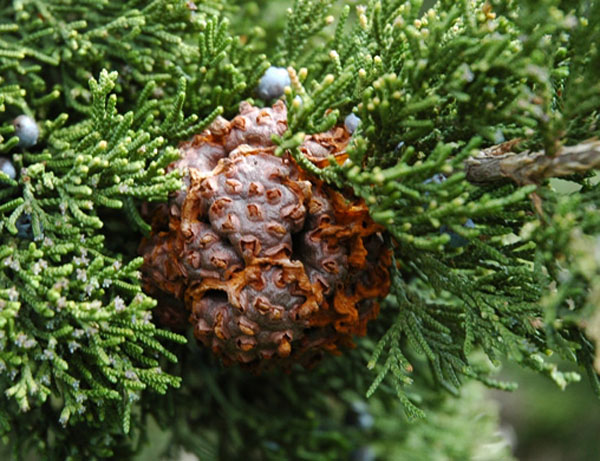Issue 1, April 17, 2009
Cedar-Apple and Related Rusts
Cedar-apple rust is a common rust disease on Illinois edible apple and crabapple. Two other closely related rusts in Illinois are cedar-hawthorn rust and cedar-quince rust. As you might guess from the names, two hosts are associated with each disease. Half the life cycle occurs on redcedar or other juniper species. A species in the Rosaceae family hosts the other half of the life cycle. Cedar-apple is the most common. We occasionally see cedar-hawthorn rust, but it only causes some aesthetic damage, seen as leaf spotting on hawthorn. Cedar-quince rust is actually the most damaging to landscape trees. On hawthorn the disease causes deformed swellings and galls, infected fruit, and stem tip dieback. This disease may also infect serviceberry, flowering quince, cotoneaster, crabapple, pears, and mountain-ash. Still, the most common host seen at the Plant Clinic is hawthorn.
If you choose to control these diseases, focus on protecting the rosaceous hosts: apple, crabapple, or hawthorn. Galls form on the cedar/juniper hosts, but these galls do not harm the cedar/juniper. Soon, however, the galls will swell. Spore horns will form. A series of spore releases occurs and rust spores will blow onto nearby apple, crabapple, or hawthorns. As of this writing, the cedar apple rust galls in Champaign looked like those in the image. If you are to protect the alternate host, you need to use sprays that will protect the host when spores from these galls invade. Moderate temperatures (50s and 60s Fahrenheit) and moist conditions favor infection of the alternate host.

Chemical options for control are listed in the Illinois Commercial Landscape and Turfgrass Pest Management Handbook or the Illinois Home, Yard, and Garden Pest Guide. Fungicides are preventive, intended to protect plants from infection. Many chemical options are listed. Review the information at the end of the chapter that lists the mobility of each product. Generally systemic products will withstand effects of rain, will provide better protection, but are more expensive than contact chemicals. Sprays are applied to hawthorns as flower buds begin to open. Sprays are continued until 1 to 2 weeks past petal fall.
If these diseases are problems annually, you may want to consider a more permanent solution. Resistant varieties are available to many of the rust diseases. English hawthorn is reported to be resistant to hawthorn rust. We do not know of any resistance of hawthorn to cedar-quince rust. Thornless cockspur hawthorn and Washington hawthorn are quite susceptible.
If cedar-apple or related rusts have been a problem, try the following:
1.)Where possible, try to keep redcedars and the alternate hosts separated. Although spores can be blown a mile or more to the alternate hosts, most infections occur within a few hundred yards (several lengths of a football field).
2.) Use resistant species of junipers, crabapples, apples, and hawthorns in new plantings. A good source of information on crabapples for Illinois can be found at http://www.extension.uiuc.edu/IPLANT/plant_select/trees/Selecting_Crabapples.pdf (Adobe PDF). Resistance information is provided for cedar-apple rust, scab, and fire blight. Juniper resistance information is available in Diseases of Trees and Shrubs, 2nd edition, by Sinclair and Lyon.
3.) If fungicides are the chosen management option, make sure you start applications as stated above, continuing according to label recommendations until 2 weeks after petal fall. That time period represents the most common window for infection by these rust pathogens.
For more information on Cedar-Apple and Related rusts, refer to the fact sheet on these diseases, RPD #802, Rust Diseases of Apple, Crabapple and Hawthorn (Adobe PDF). This report is available free of charge. For those who grow edible apples, take a look at the Illinois Fruit and Vegetable News.--Nancy Pataky
Author:
Nancy Pataky